Affiliate disclosure: This post may contain affiliate links. Please see our Privacy Policy.
Turkey Tail Mushrooms are one of the most common mushrooms in the forest, and they grow all around the world. They grow on almost any type of wood, and there are no known poisonous look-alikes. Yet they’re also one of the most expensive medicinal mushrooms to buy. The high price tag is not because they’re difficult to forage, but driven by the fact that they have so many astounding medicinal benefits.
Most people are a bit intimidated by foraging their own medicinal mushrooms, and they’re willing to defer to others, even if it means paying a steep price for the privilege.
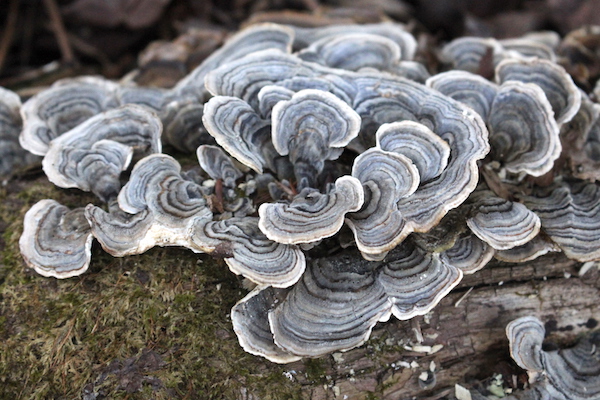
Turkey Tail mushrooms are known by three different scientific names: Trametes versicolor, Coriolus versicolor, and Polyporus versicolor. All three Latin names for turkey tail mushrooms refer to the same common medicinal mushroom.
The Chinese call them Yun Zhi (cloud fungus) and the Japanese call them Kawaratake (mushroom by the riverbank).
Where to Find Turkey Tail Mushrooms
One of the best things about foraging turkey tails is they’re available year-round, and they can be found just about anywhere in the world. They usually grow on dead hardwood stumps and downed hardwood trunks or branches. On occasion, they’ll even grow on conifers.
On our land, they seem to prefer decaying ironwood logs in wet places. When a dead/rotten ironwood falls in the woods, we’ll even carry it to a wet spot that tends to accumulate a bit of standing water after rains. In a few years, they’ll be covered with turkey tails.
This is pretty rudimentary “field cultivation” but apparently turkey tail mushrooms are very easy to cultivate. There are detailed instructions on growing turkey tails in both Growing Gourmet and Medicinal Mushrooms (by Paul Stamets) and Organic Mushroom Farming and Mycoremediation (by Tradd Cotter).
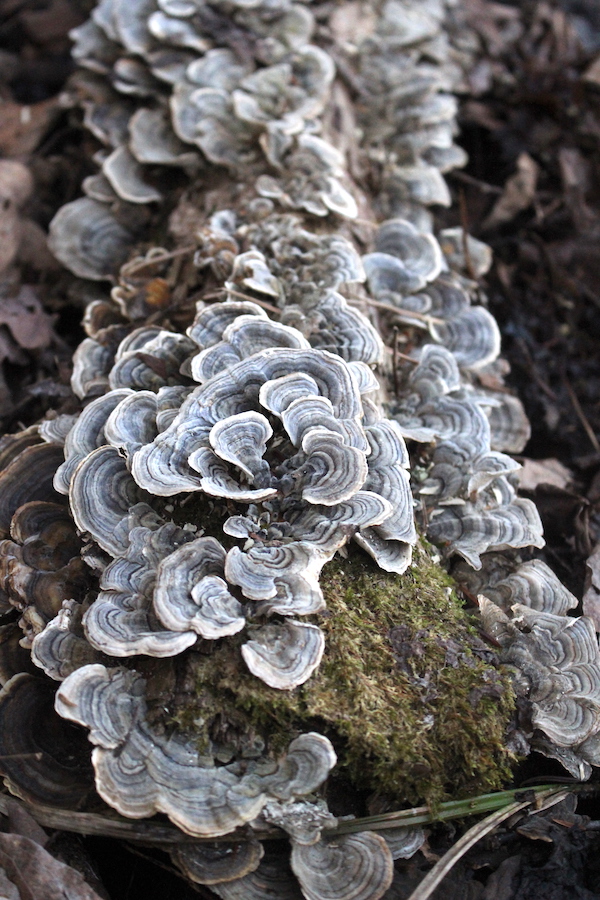
Identifying Turkey Tail Mushrooms
Turkey tail mushrooms have a surprising number of look-alikes, but with close inspection, you should be able to identify the true turkey tail. Mushroom Appreciation has a 6 step process for identifying turkey tail mushrooms, and I’m going to take you through it step by step.
Does it have pores on the underside?
Turkey tail mushrooms are a polypore, meaning that it has pores on the underside like several other medicinal mushrooms including reishi and tinder polypore.
The closest look alike are types of crust fungus, namely Stereum ostrae. They look enough alike that these actually go by the common name “false turkey tail.” From the top surface, they look pretty darn similar. They both have rings of color, they’re both thin and tough. Once you flip them over, it’s easy to tell the difference.
Stereum ostrae does not have pores on its underside. The underside is completely smooth. It’s not known to be toxic, but it’s not known to be explicitly edible either. Some have tried to use it medicinally, and studies are showing that types of crust fungus may be antibiotic (source), but there’s been so little research that it can’t truly be classed as safe.
How big are the mushrooms pores?
This is where it gets a bit tricky. Once you’ve identified that your potential turkey tail mushroom has pores on the underside, take a really close look.
Are the pores fairly easy to see, or do you really need to squint to see them? Some Trametes species have larger pores, with roughly 1 to 3 pores per millimeter. True turkey tails have very small, pores that are only just barely visible, at a rate of 3 to 8 pores per millimeter.
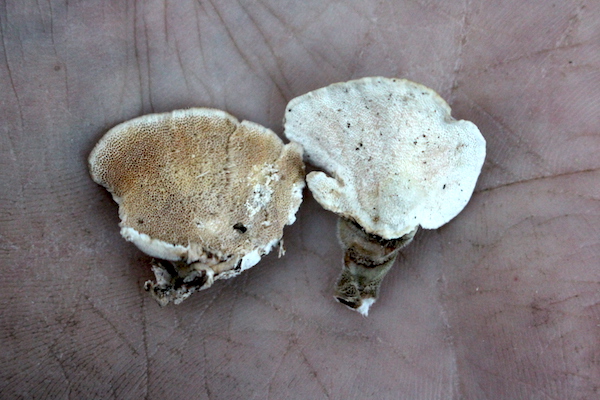
It can help to use the top of a ballpoint pen, which is usually a bit under 1 mm across. Put it up next to the pores, and you should be able to see 3+ pores in the space occupied by the tip of the pen.
If it has less than 3 pores per mm then you have another species of Trametes. That’s not necessarily a bad thing, and it may still be a medicinal mushroom, it just means you need to do a bit more digging to properly identify your find.
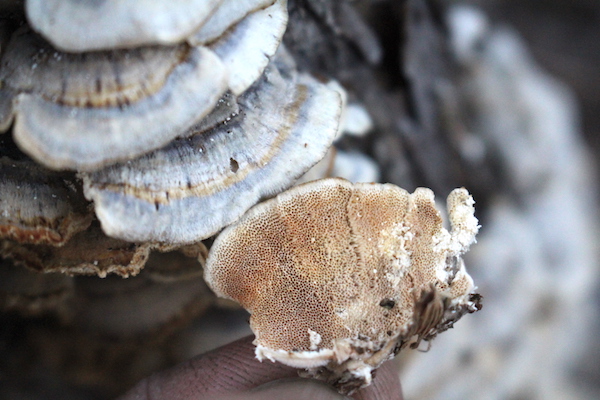
Is the mushroom surface fuzzy?
I know this is a strange one, and it’s actually pretty difficult to see with the naked eye. The “fuzz” on a turkey tail mushroom actually glistens a bit in the light, and gives them a slight silver sheen when the light hits them just right. You can actually feel it with your fingers, and it’s much easier to see with a magnifying glass. Think fuzzy like velvet, not hairy.
If it’s not fuzzy, velvety or even slightly hairy then you have a different species of Trametes.
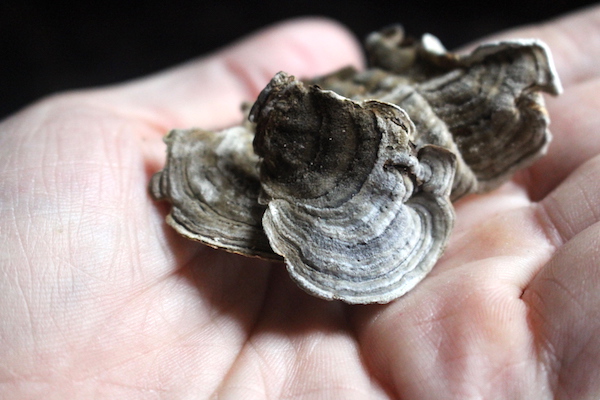
Is the cap all white/grey-ish?
Another turkey tail look alike, known as Hairy Bracket Fungus (Trametes hirsuta) looks a lot like turkey tail mushrooms, but instead of surface colored by striped rings, it’s mostly white-ish to grey-ish. Looking at pictures of this turkey tail look alike, it seems much furrier and the solid color really helps you distinguish between these Trametes species.
True turkey tail mushrooms have distinct color zones across their top, and are not all one color.
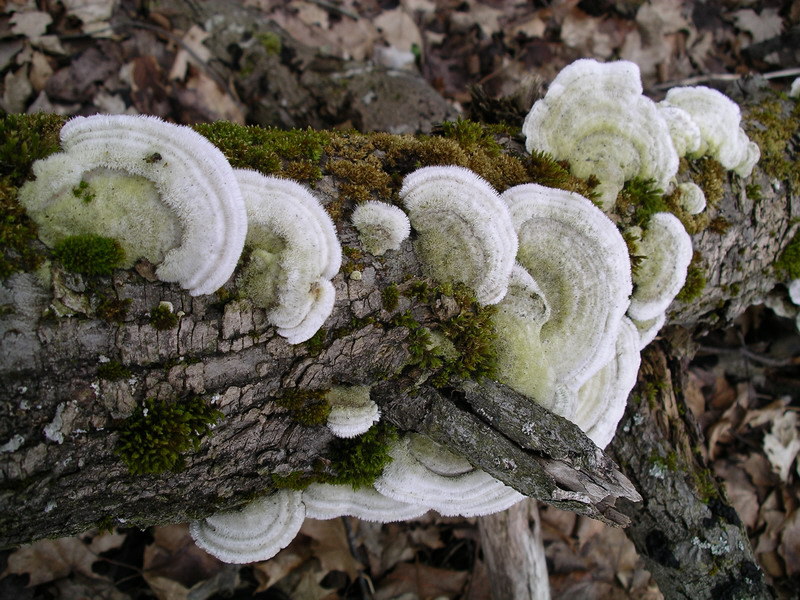
Does the Cap Have Starkly Contrasting Color Zones?
Just as the hairy bracket fungus look-alike was differentiated by color, another turkey tail look-alike is differentiated by a lack in contrasting color zones. If the cap lacks starkly contrasting color zones, or if the “zones” are just textural zones, or if they seem to be very subtle shades of the same color, then you have Trametes pubescens.
This one, like hairy bracket fungus, doesn’t look anything like true turkey tail mushrooms to my eye, but it matches the other turkey tail indicators listed up until now.
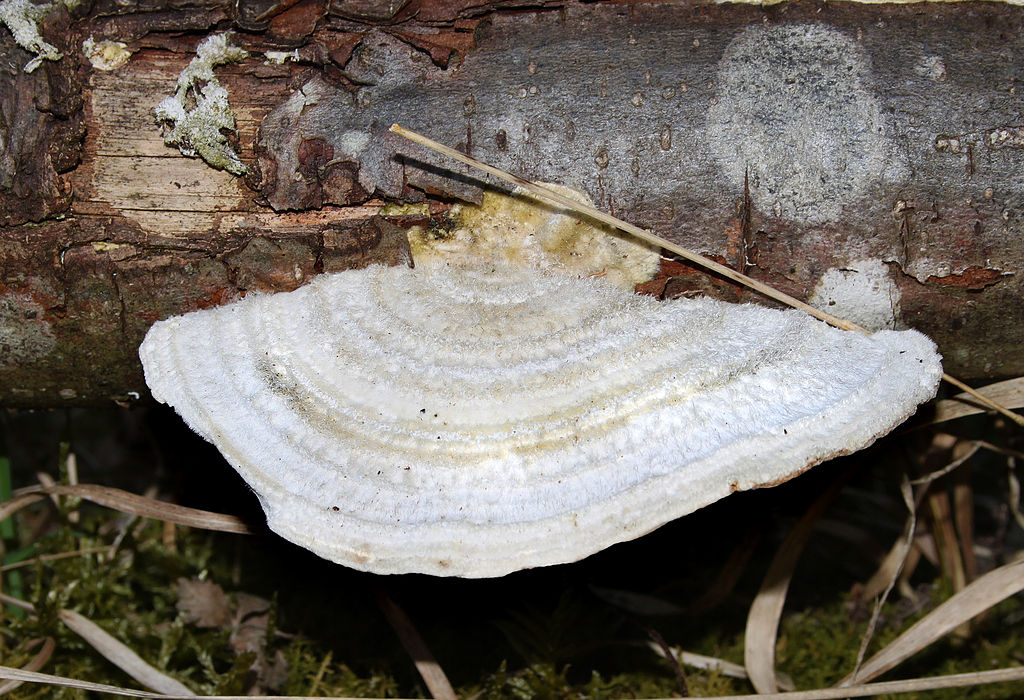
Is the fresh mushroom thin and flexible?
As turkey tail mushrooms age, they dry out a bit, especially once they’ve been harvested. Still, they’re very thin and they should be somewhat flexible even when dried. If the mushrooms are rigid and hard, then you have Trametes ochracea.
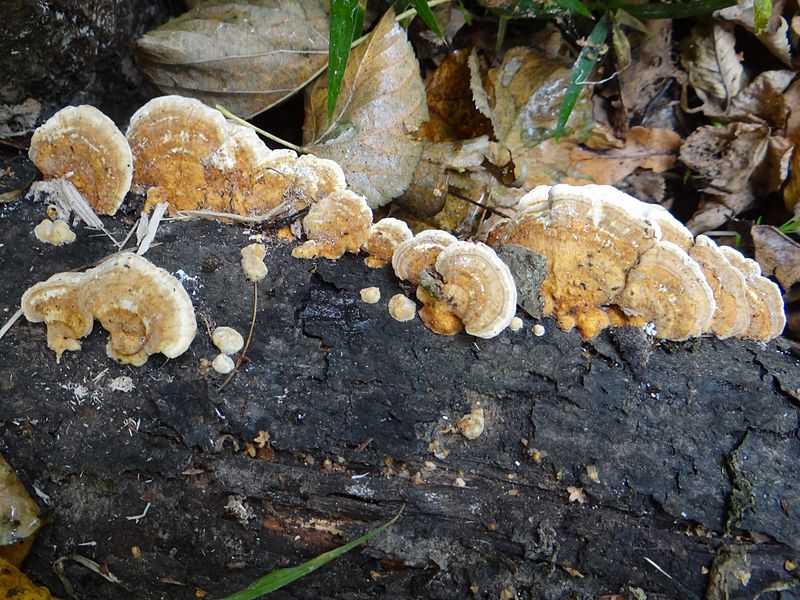
Turkey Tail Mushroom Identification Checklist
So now to review…here’s your turkey tail mushroom identification checklist:
- Pores on the underside
- Pores are very small, barely visible, roughly 3 to 8 pores per millimeter
- Surface very slightly fuzzy, just barely visible
- Cap has starkly contrasting color zones (not just textural ridges)
- Fresh mushrooms are thin and flexible
- Cap color variable, but often contains white, grey, brown, and reddish brown
Medicinal Benefits of Turkey Tail Mushrooms
Now that you’ve positively identified a turkey tail mushroom, you’re wondering what all the fuss is about. What are the benefits of turkey tail mushrooms? Why bother seeking them out?
I’m not a doctor, and I don’t play one on the internet. That said, there’s a pretty broad scientific consensus that Turkey Tail mushrooms have the following medicinal uses:
- Help improve immune responses against infection and common illnesses (including the common cold) (Source, Source)
- Improves cancer survival rates (5-year survival post diagnosis) when used in combination with traditional cancer treatments (According to the National Cancer Institute)
- Can help combat HPV when used along with Reishi Mushroom Extract (Source)
- Turkey tail mushrooms are rich in antioxidant compounds, helping the body fight free radicals and adapt to oxidative stress (Source, Source)
- Contains prebiotic compounds that help to improve digestion, and can help promote a healthy microbiome. This prebiotics promote healthy gut flora, that can reduce diarrhea, improve immune function, lower cholesterol, along with many other benefits of healthy gut function. (Source)
Using Turkey Tail Mushrooms
While most medicinal mushrooms are consumed as a double extraction tincture, where the medicinal compounds are first extracted in alcohol and then by extended boiling, turkey tails are a bit different. Generally, turkey tails are used as a simple mushroom tea, or taken in powdered form in as mushroom capsules. They’re also an ingredient in this Mushroom Chai Latte mix designed to help promote digestion with mushrooms and digestive herbs/spices.
If you’ve harvested your own turkey tail mushrooms, start by drying any mushrooms you won’t use immediately. This ensures that they’ll keep without spoiling for extended periods, as they’ll sometimes develop mold if not dehydrated. Most food dehydrators run at somewhere around 115 to 120 degrees, and at that temperature, it takes about 18 to 24 hours to fully dehydrate turkey tail mushrooms.
If you have a large harvest, a high capacity dehydrator can be a real lifesaver. I’ve also heard that home freeze dryers are exceptionally effective at preserving mushrooms for long term storage.
Turkey tail mushrooms can also be frozen for teas later on. Since we live off the grid, dehydrating them is a much better option because it doesn’t use up valuable freezer space.
Turkey Tail Mushroom Tea (or Decoction)
While it’s often called turkey tail mushroom tea, it’s not as simple as just pouring boiling water over the mushrooms. Turkey tails require an extended boil to fully extract. Start by simmering about 1 cup of chopped turkey tail mushrooms in about 6 cups of water for 1 hour. At the end of the long simmer, most of the water should have evaporated, and you should have around 1 cup full of turkey tail tea once you strain the mushrooms from the water.
Stoves vary, and you may need to keep adding water to prevent the pot from boiling dry.
Turkey Tail Mushroom Dosage
I have yet to find any definitive guidance on turkey tail mushroom dosage. When taken in capsule form as a dietary supplement, the bottles suggest two capsules per day. As a tea, I can only guess that one cup of slowly simmered turkey tail mushroom tea would be the appropriate dosage.
That’s what I’m starting with trying to improve my immune system as I wrangle my two toddlers. They’re wonderful young foraging assistants, but they’re also little plague factories and they’re putting my immune system to the test.
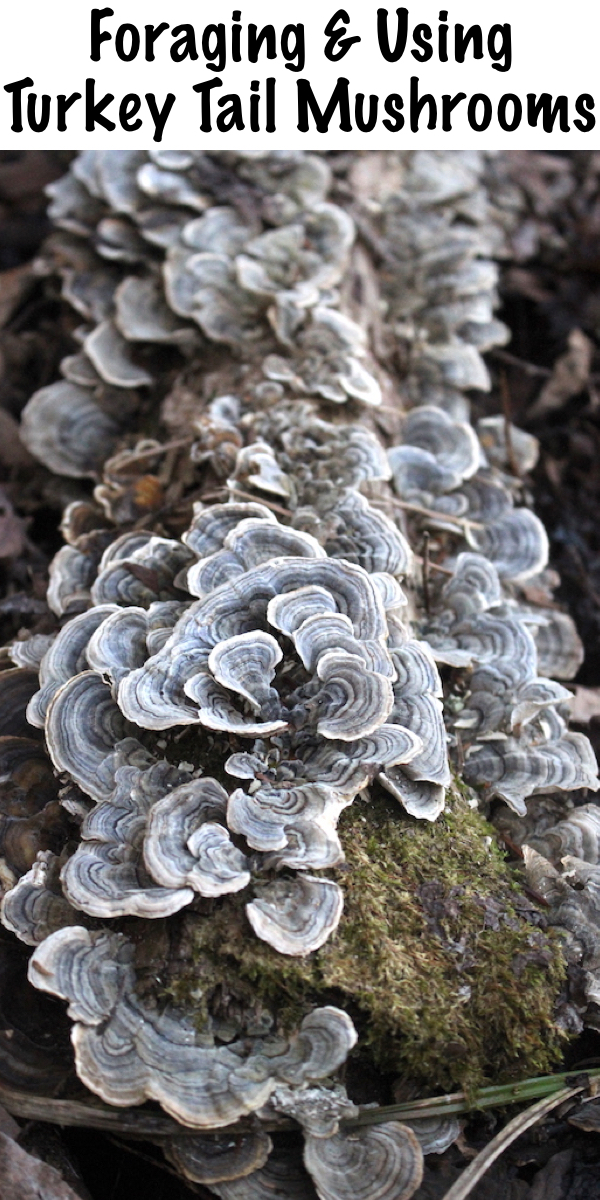

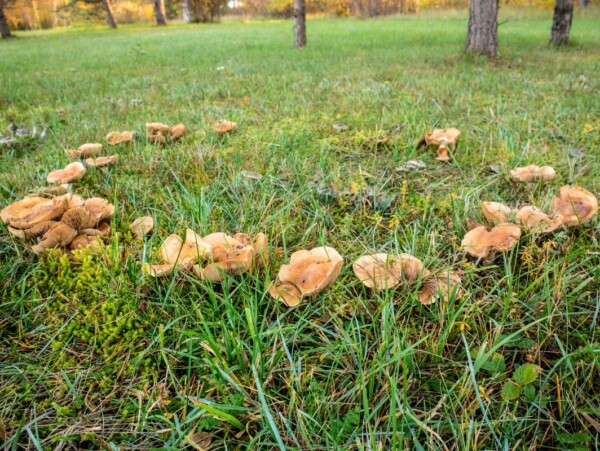
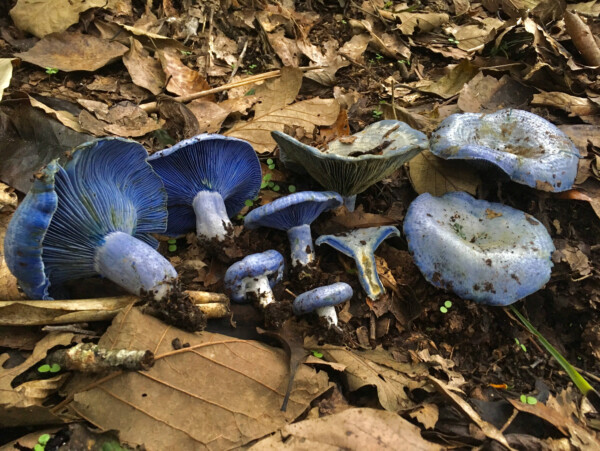
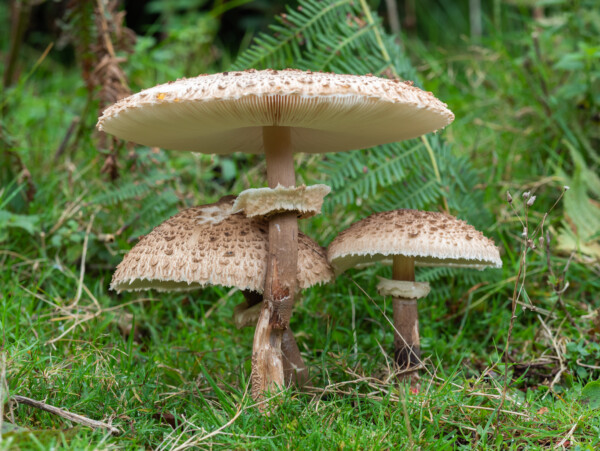










I believe you have noted some very interesting points, appreciate it for the post.
Great article but the sheer amount of ads on your blog is so distracting I wont be coming back
Thank you for the feedback. I do understand that the ads can sometimes be distracting. Creating this amount of content requires a great deal of time as you can imagine and the ads are one of the ways that we provide for our family. We have created a subscription based program which is ad free for those that are interested. You can sign up for the newsletter here to get more information. https://practicalselfreliance.com/
Great article, I put my Turkey Tail Mushrooms in the dehydrator and when completely dried I store them in a mason jar along with a silica pack to take care of any more moisture. I just take a few at a time and grind them in a spice grinder, add some boiling water, steep for 10 – 20 minutes add a little honey and I have a wonderful-tasting tea. I hope I’m getting the benefits by doing it this way.
A tea made with turkey tail mushrooms is a very effective method for getting the benefits.
Thank you for the great article. I have eaten three Turkey Tails every morning for over fifteen years (now 71) and I do not think I have been sick at all in that time. I enjoy the flavor and texture and just chew until completely gone. A great way to start your day.
That’s wonderful. Thanks for sharing.
i’ve found turkey tails (80% confident) but they have blackened, burnt looking edges? top side and bottom side. i can guarantee there’s been no fires in the area for many years. are they diseased or just old?
I would guess that they are old.
I am wondering about throwing some of these in with my leftover Thanksgiving turkey carcass whenI make my broth . Yea or nay?
Yup! Medicinal mushroom broth is totally a thing, and tasty. Just be confident on your ID obviously, but then add them right in with the bones. Enjoy!
Awesome Read! Thank you so much for the info. I live in a cornucopia of these little gems!
You’re welcome. So glad you enjoyed the post.
Can these be grounded and then made into acts? Also can they be used in recipes? Thank you!
Turkey tails are generally taken as a tea or taken in powdered form in a capsule. They are also included in this mushroom chai latte mix https://www.amazon.com/Four-Sigmatic-Turkey-Reishi-Mushrooms/dp/B07CYWMP97/ref=as_li_ss_tl?keywords=mushroom+coffee+turkey+tail&qid=1555628238&s=gateway&sr=8-42&th=1&linkCode=sl1&tag=selfrelianc0e-20&linkId=88d40176f022e50c345e905bde289b5e&language=en_US
What colour on the underside should they be and what colours do you avoid? I picked some that are not pure white, more of an off white colour (Kind of white mixed with orangy brown
The underside color of a turkey tail is described as whiteish to pale brownish.